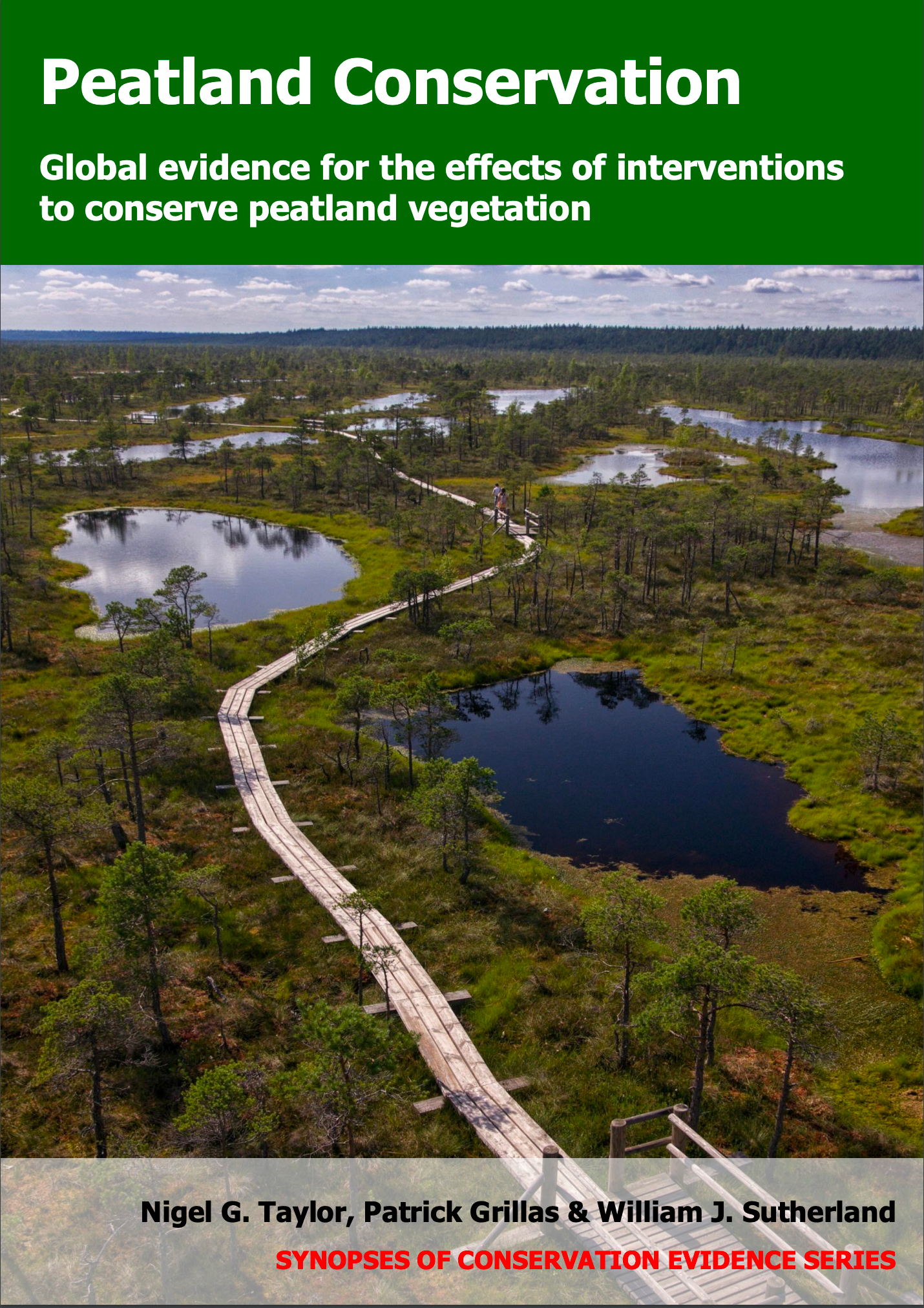Restore/create peatland vegetation using the moss layer transfer technique
-
Overall effectiveness category Likely to be beneficial
-
Number of studies: 4
View assessment score
Hide assessment score
How is the evidence assessed?
-
Effectiveness
70% -
Certainty
60% -
Harms
1%
Study locations
Supporting evidence from individual studies
A controlled, before-and-after, site comparison study in 1999–2003 in a historically mined bog and 92 natural bogs in Quebec, Canada (Mazerolle et al. 2006) reported that an area restored using the moss layer transfer technique developed greater vegetation cover than an unrestored area, and that vegetation in the restored area was more similar to that of natural bogs. These results were not tested for statistical significance. After four years, the restored area had 49% moss cover (vs unrestored: 2%; natural: 85%), 19% herb cover (unrestored: 8%; natural: 19%) and 8% shrub cover (unrestored: 13%; natural: 51%). In autumn 1999, 8.4 ha of historically mined bog were restored by levelling the surface, rewetting (blocking drainage ditches and building embankments), adding plant fragments from the surface of a nearby natural peatland, straw mulching, and phosphorous fertilization. An adjacent 3.1 ha was not restored. In August 2003, vegetation cover was recorded in 3 x 8 m quadrats: 32 in the restored area and 15 in the unrestored area. Vegetation cover in 92 nearby natural (unmined) bogs was recorded in 2000. This study was based on the same experimental set-up as (2) and (3).
Study and other actions testedA replicated study in 1997–2012 in 12 historically mined bogs in Canada (González et al. 2013) reported that most areas restored using the moss layer transfer technique developed a community of bog-characteristic plant species within 4–11 years. These results are not based on tests of statistical significance. Of 34 restored areas, 23 had developed a community of bog-characteristic plants (data reported as a graphical analysis). These areas were dominated by red bog moss Sphagnum rubellum (37% cover) and cottongrasses Eriophorum spp. (4–20% cover). Eleven areas did not develop this characteristic community. Eight were dominated by haircap moss Polytrichum strictum (60% cover). Three areas developed high cover of bare peat (52% cover), birch Betula sp. (12% cover) and lichens (4% cover). Between 1997 and 2004, 34 areas in 12 historically mined bogs were restored by levelling the peat surface, rewetting (blocking drainage ditches), adding Sphagnum-dominated vegetation fragments and mulching with straw. Some areas were also fertilized with phosphorous. Vegetation cover was estimated 4–11 years after intervention: vascular plants in 1 x 1 m quadrats (4–128/area) and bryophytes in 25 x 25 cm quadrats (20–640/area). This study included the site restored in (1), (3) and (4).
Study and other actions testedA controlled, before-and-after study in 1998–2007 in a historically mined bog in Quebec, Canada (Poulin et al. 2013) reported that an area restored using the moss layer transfer technique developed a more peatland-characteristic plant community than an unrestored area, with higher richness and diversity of characteristic plants (and higher overall plant species richness). These results were not tested for statistical significance. Before intervention, both areas contained a similar community of weedy, shrubby and forest plants. Over eight years, the restored area developed a community of peatland-characteristic plants but the unrestored area did not. Red bog moss Sphagnum rubellum became particularly abundant in the restored area (data reported as graphical analyses). After eight years, the restored area contained more plant species than the unrestored area (21 vs 17), more peatland-characteristic plant species (11 vs 3; before intervention: 1) and more wetland-characteristic plant species (2 vs 0; before intervention: 0). The restored area also had higher diversity of the characteristic species than the unrestored area, but lower total plant diversity (data reported as diversity indices). In 1999, 8.4 ha of historically mined bog were restored by levelling, rewetting (building embankments and blocking drainage ditches), adding Sphagnum-dominated vegetation fragments and mulching with straw. Fertilizer was added the following summer. In the same peatland, 3.1 ha were not restored. In 1998 and 2001–2007, cover of every plant species was measured using rods dropped at over 7,000 points along transects. This study was based on the same experimental set-up as (1) and (4).
Study and other actions testedA controlled, before-and-after study in 1999–2007 in a historically mined bog in Quebec, Canada (Rochefort et al. 2013) reported that an area restored using the moss layer transfer technique had greater cover of bryophytes and herbs, and lower tree/shrub cover, than an unrestored area. These results were not tested for statistical significance. After eight years, the restored area had total bryophyte cover of 79% (vs 19% in the unrestored area), Sphagnum moss cover of 60% (unrestored: 0%), total herb cover of 76% (unrestored: 18%) and sheathed cottongrass Eriophorum vaginatum cover of 50% (unrestored: 5%). In contrast, the restored area had only 5% tree/shrub cover, compared to 23% in the unrestored area. Before restoration, vegetation cover was low (e.g. bryophytes <15%, herbs <20%) and similar across areas later restored and unrestored. In 1999, 8.4 ha of historically mined bog were restored by levelling, rewetting (building embankments and blocking drainage ditches), adding Sphagnum-dominated vegetation fragments and mulching with straw. Fertilizer was added the following summer. In the same peatland, 3.1 ha were not restored. In July 1999 (before restoration) and biannually between 2001 and 2007, plant species were recorded at approximately 5,700 points across the bog. Similar results were obtained when cover was visually estimated in forty-three 3 x 8 m quadrats. This study was based on the same experimental set-up as (1) and (2).
Study and other actions tested
Where has this evidence come from?
List of journals searched by synopsis
All the journals searched for all synopses
This Action forms part of the Action Synopsis:
Peatland Conservation
Peatland Conservation - Published 2018
Peatland Conservation





)_2023.JPG)














